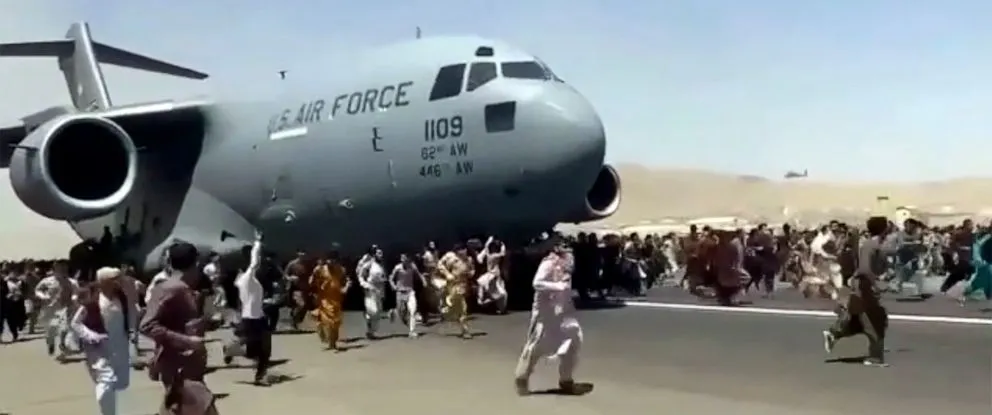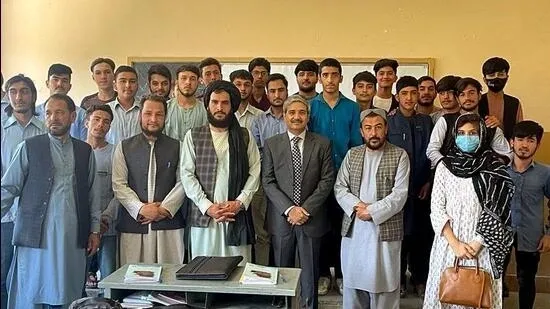Ever since the Trump administration signed a peace deal with the Taliban in February 2020 that paved the way for the US withdrawal from Afghanistan, his successor Joe Biden continued with the pullout despite the Taliban’s rapid blitz across the country from the end of July. As the last US airforce C 17 took off from Kabul airport one minute before midnight on August 31, 2021, the Taliban fighters watching US planes disappear into the sky over Afghanistan fired their guns into the air, celebrating victory after a 20-year insurgency that drove the world’s most powerful military out of one of the poorest countries.
Zabihullah Mujahid, Spokesperson, Taliban, declared to the media in delight the following day, “American soldiers left the Kabul airport, and our nation got its full independence”. It sums up the end of the 20-year war of the US with the Taliban, who governed the country under a harsh interpretation of Islamic law from 1996 to 2001 back in power. The Taliban controls all of Afghanistan except for the mountainous Panjshir province, where a few thousand local fighters and remnants of Afghanistan’s collapsed security forces have pledged to resist them. The renewed Taliban face much graver challenges as they fought back and govern one of Earth’s poorest and most war-ravaged nations. During the cold war days, dating back to the late 1970s, the Taliban was created by the dirty nexus of the CIA and ISI to counter the Soviets who had captured most of the country.
1979 the watershed year:
The USA enjoyed the unsolicited friendship of Mohammad Reza Pahlavi, who was overthrown in the Iranian Revolution in January 1979. The successor Ayatollah Khomeini, a Shiite, was the first religious leader to openly condemn the Shah’s program of westernization, much to the discomfort of the USA questioning its hegemony in the region. Khomeini termed the November 20, 1979 rebel raid on Mecca in Saudi Arabia as the tacit ‘handiwork’ of the US and Israeli governments.
Reacting to Khomeini’s statement, angry anti-US protestors set the US Embassy in Islamabad, Pakistan on fire the next day. Adding to these events, in the Middle East and Pakistan, the entry of the Russian Army into the communist-friendly neighbor Afghanistan in December 1979 further worried the USA of losing political control in the region.
The then leadership of the USA (President Jimmy Carter) could not digest the back-to-back developments of the loss of Iran and the bitter enemy USSR venturing into Afghanistan. On the other hand, the political leadership in America and Pakistan (Gen Zia ul Haq) was not on talking terms as Gen Zia overthrew Bhutto from power, hanged him to death, and escalated nuclear programming despite solid warnings.
As the political leadership could not mitigate the slipping ground, the CIA came up with a ‘dual action’ plan to gain the lost ground in the region and decimate the USSR from Afghanistan. In collusion with the now-notorious ISI of Pakistan, the CIA, at the beginning of the 1980s, devised an action plan to support the local warlords and fighters of Afghanistan who were termed as ‘Mujahedeen’s’ – that broadly refers to Islamic guerrillas who engage in jihad.
The Formation of Taliban:
The notorious duo of CIA and ISI imported fighters from across the globe and started imparting insurgency training by establishing refugee camps in the Peshawar region of Pakistan on the Afghan-Pak border. The Radical Islamist ideology of ‘Muslim Brotherhood’ of Egypt was embraced to give more vehemence to the fighters’ cause, and renowned preachers and eminent scholars from Al-Azar, Madinah, and Jeddah universities of Saudi Arabia, Egypt, Jordan, and other Muslim neighborhoods countries roped in to spread the radical ideology (cause for jihad). Prominent among the religious figures were Hafiz Saeed (Co-founder of LeT), Masood Azhar (Founder of JeM), and Abdullah Yusuf Azzam (mentor of Osama Bin Laden).
Abdullah Yusuf Azzam, who helped to form Hamas and Lashkar-e-Taiba and Osama Bin Laden (the Saudi billionaire turned US nemesis), founded ‘Maktab al-Khidamat (MAK)’ (Services Office), training the foreign recruits imported from across the globe with the covert support from both CIA and ISI in Peshawar region of Pakistan on the Afghan-Pak border. The countries like the UK, France, China, and Switzerland exported weapons and finances tacitly to the newly formed MAK.
The MAK started with a few hundred fighters called ‘Talibs’ (meaning Students) in the early 1980s and swelled into thousands of highly radicalized non-Afghan army– ‘Taliban’ (army of students) by the end of 1988. Azzam traveled internationally and, during his lifetime, is believed to have alone recruited 20,000 fighters from over 20 countries, including Saudi Arabia, Yemen, Algeria, Tunisia, Egypt, and CIS countries. The frustrated Soviets, who suffered heavy casualties in the nine-year war, exited Afghanistan in February 1989, giving a sense of victory to MAK, aka Taliban, which started stamping their radical imprints across the globe.
The Taliban, which refers to itself as the Islamic Emirate of Afghanistan (IEA), is a Deobandi Islamist religious-political movement and military organization in Afghanistan. After the exit of the Russians, the Pashtun-dominated Taliban slowly started capturing Afghanistan from the southern city of Kandahar with brutal militia power under the leadership of Mohammed Omar, an Afghan Mullah (Cleric). The death of Najibullah, the then president of Afghanistan, and Hekmatyar’s Hezb-e Islami Gulbuddin’s refusal to recognize the interim government and effort to take power for itself started the civil war in 1992. As a result, Pakistan supported and funded the Taliban gaining traction during 1994 till they took over the seat of power in 1996.

Differences between Abdullah Yusuf Azzam and Osama Bin Laden and the formation of Al Qaeda:
Following the Soviet withdrawal from Afghanistan in 1989, Azzam theorized that Muslims should fight a single, global jihad against their enemies instead of smaller, separate national fights and take the jihad to the Palestinian territories.
However, Bin Laden stayed in Afghanistan and combined forces with Ayman al-Zawahiri to form the dreaded Al-Qaeda in late 1988.
Azzam separated himself from the newly formed alliance due to his disagreement with al-Zawahiri’s goal of waging jihad in Afghanistan, as it called for Muslims to kill other Muslims. Instead, Azzam established a network to recruit Palestinians to train in Afghanistan for an eventual fight with Israel, which led to the formation of ‘Hamas’.
The emergence of Al Qaeda:

Al-Qaeda began as a logistical network to support Muslims fighting against the Soviet Union during the Afghan war. Refused patronage from his native country Saudi Arabia to wage a war against anti-Muslim forces including the USA, Osama shifted his base to Sudan. However, in 1996, under heavy international pressure, Sudan expelled Bin Laden, and he returned to Afghanistan, where he received protection from the ruling Taliban.
Later that year, Bin Laden issued the first of two ‘fatwās’ (religious opinions) declaring a holy war against the United States, which he accused, among other things, of looting the natural resources of the Muslim world, occupying the Arabian Peninsula, including the holy sites of Islam, and supporting governments servile to US interests in the Middle East. Bin Laden’s apparent goal was to draw the United States into a large-scale war in the Muslim world that would overthrow the existing world order and establish a single Islamic state.
Al Qaeda, under the active patronage of the ruling Taliban in Afghanistan, established camps for Muslim militants and engaged in numerous terrorist attacks, including the destruction of the US embassies in Nairobi (Kenya) and Dar es Salaam (Tanzania) in 1998 and a suicide bomb attack against the US warship Cole in Aden (Yemen) in 2000. In 2001, 19 militants associated with Al-Qaeda staged the September 11 attacks against the United States. Weeks after the attacks, the US government responded by attacking Taliban and Al-Qaeda forces in Afghanistan and the start of the now infamous ‘war of insurgency in Afghanistan in September 2001. The Taliban, which went down along with Al Qaeda, resurfaced in 2021 under the leadership of Hibatullah Akhundzada and, to everyone’s surprise, barged into Kabul, taking back the seat of power even before the mighty superpower finished its assured exit.
The big question – What next now?
It remains unclear how the Taliban plan to govern and rule Afghanistan. Despite claims by the Taliban leaders that the group will respect the rights of women and minorities “as per Afghan norms and Islamic values”; Women in particular face an uncertain future. Another major fear is that the country will once again become a training ground for terrorism. However, Taliban officials say they aim only to implement an “Islamic government” and will not pose a threat to any other country and insist that they will fully adhere to the US deal and prevent any group from using Afghan soil as a base for attacks against the US and its allies.
However, the analysts say the Taliban and Al-Qaeda are inseparable, with the latter’s fighters heavily embedded and engaged in training activity inside Afghanistan.
Taliban is not a centralized and unified force, and this may lead to differences amongst them as some leaders may want to keep the deal brokered with the US honored by not stirring up trouble, but hardliners in the group may be reluctant to break links with Al-Qaeda. It is still not known how powerful Al-Qaeda is and unclear whether it could now rebuild its global network like in the 1990s. As the US forces withdrew and the Taliban took over, the regional branch of the Islamic State group – ISKP (Khorasan Province) – opposed by the Taliban may try to gain footholds in Kazakhstan, Kyrgyzstan, and parts of Tajikistan, which could be a matter of serious concern.
Author’s name withheld on request.



